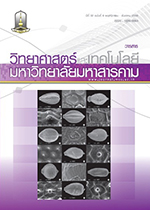แบบจำลองอุทกธรณีวิทยาเชิงมโนทัศน์และอุทกธรณีเคมีของแหล่งนํ้าบาดาล ในลุ่มนํ้าห้วยสายบาตร
Main Article Content
บทคัดย่อ
บทคัดย่อ
พื้นที่ศึกษาครอบคลุมเนินสูงดงซำ อำเภอซำสูง จังหวัดขอนแก่น อยู่ในพื้นที่ป่าสงวนแห่งชาติดงซำ เป็นเนินที่เกิดจากการสะสมตัวของกรวดทรายโดยทางนํ้าสมัยโบราณ ที่กัดเซาะระหว่างแนวสัมผัสของหมวดหินโคกกรวดและหมวดหินมหาสารคามมีการตกตะกอนกรวด ทราย ทรายปนดินเหนียว และดินเหนียวอย่างน้อย 3 วงรอบ จัดเป็นตะกอนตะพักลำนํ้ายุคควอเทอร์นารี จากข้อมูลหลุมเจาะสามารถนำมาสร้างแบบจำลองอุทกธรณีวิทยาเชิงมโนทัศน์ เพื่อแสดงลำดับหน่วยอุทกธรณีวิทยาและทิศทางการไหลของนํ้าบาดาล โดยนํ้าจะไหลจากพื้นที่รับนํ้าที่อยู่ตอนกลางและไหลออกด้านข้างของเนินรอบๆ พื้นที่ศึกษาชั้นหินให้นํ้าเป็นตะกอนร่วนกรวดทราย แบ่งเป็นชั้นบน (ลึก < 40 ม.) และชั้นล่างลึกกว่า 40 เมตร ส่วนชั้นกันนํ้าเป็นชั้นดินเหนียวอุทกธรณีเคมีจำแนกนํ้าเป็นนํ้าจืดชนิด Ca-Na-HCO3 ชั้นหินให้นํ้าชั้นบนมีคุณภาพค่อนข้างดี มีสนิมเหล็กน้อย ส่วนที่ระดับลึกจะมีสนิมเหล็กมาก ส่วนชั้นหินให้นํ้าที่อยู่ที่ลุ่มตํ่าเป็นทราย ทรายปนดินเหนียวของลำนํ้าห้วยสายบาตรและห้วยทรายให้นํ้าจืดชั้นบน และในระดับลึกจะเป็นนํ้ากร่อยถึงเค็ม ชนิด Na-Cl เพราะพื้นที่รองรับด้วยหมวดหินมหาสารคาม การคำนวณปริมาณนํ้าต้นทุนในชั้นหินให้นํ้าในพื้นที่ศึกษา 18.7x106 ลบ.ม. และปริมาณนํ้าเพิ่มเติมในชั้นหินให้นํ้า 3.136x106 ลบ.ม. เพื่อความสมดุลของการสูบนํ้าบาดาลไม่ให้เกิดวิกฤติหรือมีปัญหาการแทรกซึมของนํ้าเค็ม ในพื้นที่ศึกษาสามารถสูบนํ้าขึ้นมาใช้ได้ในปริมาณ3-5 ล้านลูกบาศก์เมตรต่อปี
คำสำคัญ: แบบจำลองอุทกธรณีวิทยาเชิงมโนทัศน์ อุทกธรณีเคมี ห้วยสายบาตร ชั้นหินให้นํ้าตะกอนร่วน
Abstract
The study area covers the Dong Sum Upland at Sumsoong District, Khon Kaen Province. The area is a part of the Dong Sum National Forest reservation. The upland is underlain by gravel and sand deposited in the paleo channel between the contact point of the Khok Kruat and Mahasarakham formations. The sediments were classified as old terrace deposits in the Quaternary period. The deposition was started with gravel and fined upward to become sand,sand and clay and clay layer on the top. There are at least three cycles of the deposition. From bore holes lithological logs, a hydrogeological conceptual model is established including hydrostratigraphic units and groundwater flow directions.The recharge area is located in the middle of the area, whereas the groundwater discharges into the lowlands to the south and southwest. The unconsolidated aquifer can be divided into 2 levels ie., Upper aquifer < 40 m. in depth, and the deeper one is more than 40 m. in depth. The Hydrogeochemistry data can be used for classifying water types. Most of the groundwater samples show the water type as Ca-Na-HCO3 which is fresh water. However,there is very high soluble iron in groundwater, especially in the deep aquifer. In the discharge area, the water type is dominated by Na-Cl, because the area is underlain by the Mahasarakham formation. Furthermore, groundwater storage and annual groundwater recharge in the study area were calculated and yield 18.7 Million Cubic Meters (MCM.)and 3.136 MCM., respectively. For sustainable water use without critical water level decline and saltwater intrusion,the amount of groundwater use can be in the range of 3-5 MCM./yr.
Keywords: Hydrogeologic conceptual model, Hydrogeochemistry, Huai Sai Bat, Unconsolidated Aquifer

